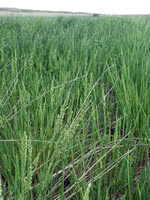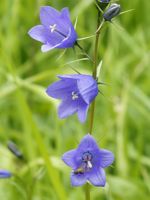Mon-Fri 9am - 5pm Mountain time
Slough Grass vs Harebell
Beckmannia syzigachne
Campanula rotundifolia
CUSTOM GROW
NOT AVAILABLE THIS SEASON - MIGHT RETURN
Slough Grass is a hardy grass that will happily grow in any wet soil. It is usually found near water and is common haymaking material or forage.
Slough Grass is also useful for erosion control and land reclamation.
Harebell is a native perennial wildflower known for its bell-shaped, blue-violet flowers. The noddling blooms occur in clusters at the top of slender stems. Blooming in bursts from summer to fall, the flowers attract pollinators such as butterflies, bees, and hummingbirds.
Regular deadheading encourages additional blooms, extending its floral display through the season. Harebell prefers areas with cooler summer climates and does poorly in those that get too hot and humid. It is well suited for native wildflower gardens, pollinator gardens, and naturalization projects.

